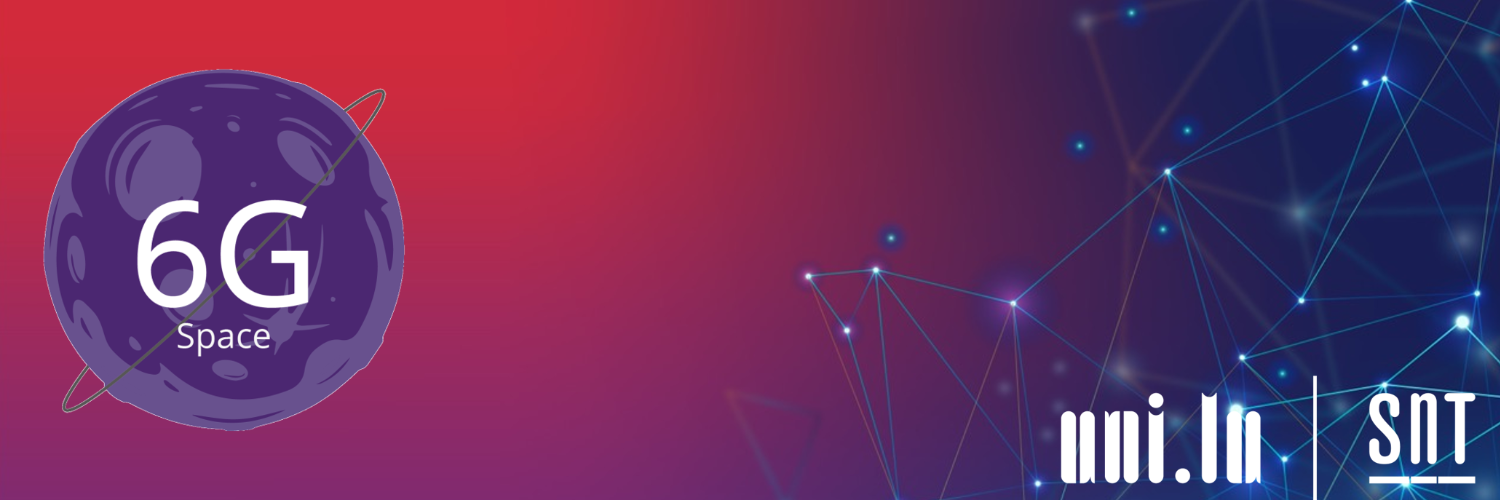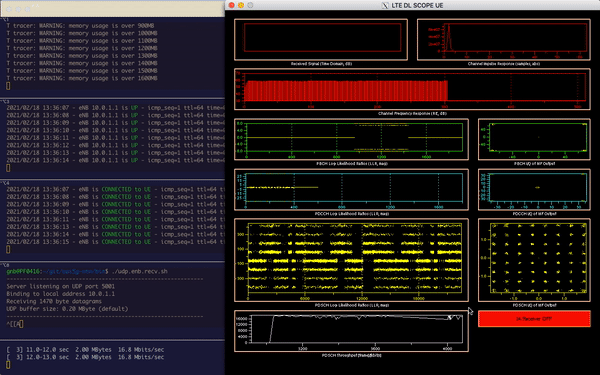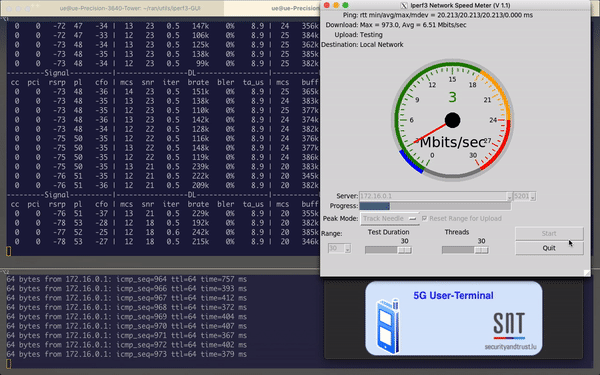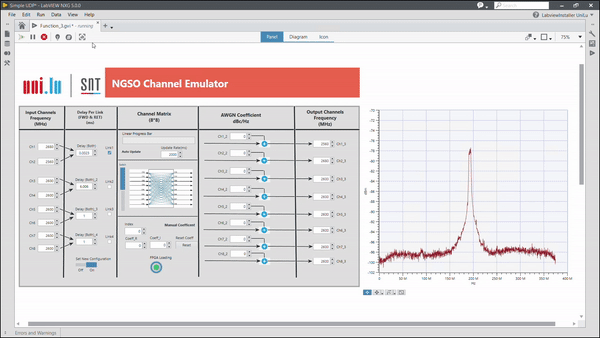¶ NTN Emulation

¶ NTN Emulation Overview
The 5G Space Communications Lab (5G-SpaceLab) is a joint project of the CDF, CubeSatLab, LunaLab and SatComLab of SnT to create a unique integrated and interdisciplinary space communications and control emulation platform for the next-generation of space applications. The 5G-SpaceLab will allow to test, validate and demonstrate space operations for many different scenarios that includes Earth-orbiting satellite communications, Earth-Moon communications among many. The main goal of 5G-SpaceLab testbed and to present its initial capacities by introducing current 3GPP standards such as 5G and Beyond into the space applications. The mentioned capacities include the evaluation of different small satellite formation control and cooperation configurations for non-terrestrial 5G networks or the realistic emulation of a space mission control room for communications and remote control of lunar rovers, and assets.
¶ Testbed Architecture
The hardware testbed architecture is composed by different elements which are based on FPGAs and software-defined radios. This includes the ground nodes, mobile-terminals, and satellite payloads. The ground nodes (base station or mobile-terminals) are implemented using OpenAirInterface 4G/5G and srsRAN stack running on top of intel-based processors and coupled with USRPs for the RF signal generation and acquisition part.
The satellite channel emulator which is a backbone of the 5GSpacelab testbed is implemented on top of a customised FPGA boards from Vadatech company. The Channel emulator is able to reproduce the effects of the NTN channel such as geometry, link budget, delay and Doppler in the signals travelling from, to or between the satellites. We have as well software-defined satellite payload from GomSpace which are acting as 5G relays (transparent payload) that are monitored and controlled using GNURadio.

¶ Earth-orbiting scenario

The Earth-orbiting scenario will focus on a CubeSat 5G NTN experimentation mission. The communications payload will be based on a space-ready Software Defined Radio (SDR) from GOMSPACE (already available in the SatComLab). The SDR communications payload enables the development of flexible experimentation architectures such as bent-pipe, node-relaying or coherent distributed communications (twin payload). These payload requirements and capabilities will be co-designed in accordance with a suitable mission and spacecraft architecture for a single satellite or a small formation of CubeSats and interfaced with the Engineering Model (EM) available in the CubeSatLab in view of a future SnT mission.
Conversely to the situation in the GEO (or even MEO), commercial capacity in LEO is still a scarce resource, and if available, transparent payloads are not very common. Thus, experimentation is limited to the capabilities of the orbiting satellites. A future mission with Over-The-Air (OTA) 5G NTN testing capabilities will put SnT in a privileged position for acquiring national and international (including ESA “Space for 5G” strategic lines) funding for the next-generation 5G-enabled activities.
The existing formation flight code COSMOS will be extended for this application and demonstrated thereafter.
¶ 5G Earth-orbiting Demonstration Experiments
The video illustrates the first experiment of a direct access to A low Earth orbit (LEO) satellite. While the satellite is moving, shown by the STK software in the bottom right, the satellite channel parameters will change. The GUI of the NTN channel emulator helps to monitor the channel coefficients which are calculated by the input parameters coming from STK. Also, while runing the experiment, we can observe the spectrum of the signal (bottom left of the screen) and we can monitor the pre-defined KPIs (top left the screen). Successful data transmisión over NTN is successfuly demonstrated by combining various hardware and software elements, and by modyfing the terrestrial 3GPP protocol in order to be satellite-complient.
¶ Objectives
- Emulation of LEO orbital mission scenario.
- Integration of hardware elements in a communication architecture setup.
- Monitoring communication KPIs (SNR, BER, Throughput)
- Integration of SatCom and CDF laboratories in conducting the experiment. The experiment is developed and setup in the SatCom Lab and is run and controlled from the CDF Lab
¶ Operating environment
- SatCom Lab for developing the experiment setup and integrating communication architecture
- CDF Lab for conducting and monitoring the experiment in real-time application

¶ Hardware Componenets
-
5G USRP Ground Nodes (eNB/gNB & UE) (x2): The USRP N310 is a networked software defined radio (SDR) that transmit and receive communication signals. These are the communication nodes that act as ground stations (eNB/gNB) with which we transmit the signal and the user (UE) that receives the 4G and 5G waveforms.
-
CubeSat SDR (gSDR): Space qualified NanoCom SDR platform developed by Gomspace is used as the payload for 5G-SNT mission. This SDR platform is utilized for high-speed ground-link and inter-satellite links utilizing S- or K-band in a highly miniaturized radio system for long distance communication. It can program different topologies and configurations.
-
Channel Emulator (CE): there is two different hardware for the CE
-
The Zynq® UltraScale+™ RFSoC ZCU111 evaluation kit, This kit features a Zynq UltraScale+ RFSoC supporting 8 12-bit 4.096GSPS ADCs, 8 14-bit 6.554GSPS DACs, 4 GB DDR4 on PL. used as the Channel Emulator which connects 5G USRP Ground Nodes and the Cubesat SDR while emulating realistic conditions of the Low-Earth orbit. It integrates the communication architecture and centralizes the experiment setup emulating the delay and doppler effects.
-
The AMC574 FPGA board is a costumed industrial board based on RFSoC XCZU29DR Xilinx FPGA that support 16 channels of ADCs and DACs
-
¶ Software components
Base-Station OpenAirInterface5G

The Software is a 5G MODEM open source 3GPP compliant. It transmits the 5G waveform which broadcast network and cell information that is strictly important for establishing a connection among many user terminals (namely the forward link). In this system we use OpenAirInterface5G
- Initial Input: (only set once at run time) is a preconfigured file to set the waveform parameters including the channel bandwidth, the operating frequency band, the duplexing mode (FDD or TDD) and many other operator (MNO) specific parameters.
- Real-time Input: is the return link signal received from the channel emulator which is initially transmitted by the user-equipment.
- Output: is the forward link signal which is transmitted by the ground to node to the channel emulator that’s finally goes to the User-equipment.
User-Terminal srsRAN and OpenAirInterface5G

The Software is a 5G MODEM open-source implementing the 3GPP stack for the user-equipment. In this system we use both srsRAN: srsUE and OpenAirInterface5G UE
- Input: represents the forward link.
- Output: represents the return link.
5G Waveform coming from the NTN channel emulator for both return and forward links. Forward link: Signal transmitted by gNodeB over NTN channel. Return link: Signal Transmitted by UE over NTN channel.
NTN Channel Emulator Labview

The software receives the channel parameters based on the different scenario from Matlab-STK Link Budget software through UDP connection and transfer them with some initial parameters to the FPGA.
- Input: represents the forward and return link signals recieved from both gNodeB, UE and sattelites. In addition to the SNR, the delay of communication and the Doppler shift that is received from Matlab-STK Link Budget software.
- Output: Forward and Return signals to gNodeB, UE and Sattelite
¶ Experiment KPIs
Signal-to-Noise Ratio (SNR):
This is the most significant performance metric for a communication channel and is defined as the ratio of the signal power to the noise power. Although it is a dimensionless number, SNR is often expressed in decibels as shown in the equation below:
\Large SNR=\frac{Signal.Power}
\Large SNR=10log(10)*\frac{Signal.Power}
A signal-to-noise ratio higher than 1:1 corresponds to SNR greater than 0dB and signifies more signal than the noise. SNR is indicative of the quality of the communication channel and a high SNR represents a high quality of communication through the channel as more signal is transmitted with respect to the noise. For the laboratory experiment, the SNR is the primary performance indicator of the communication architecture and is influenced by most of the hardware components (USRP Ground Nodes, CubeSat SDR, and Channel Emulator). For 5G-SNT LEO mission, SNR will also be affected by the mission profile and performance of the CubeSat subsystems like power, antennas et al in addition to the payload (i.e. SDR).
Bit-Error Rate (BER):
In a digital communication channel, a number of bits of data transmitted could be lost or altered due to the noise, interference or distortion. This is called as bit errors. Bit-Error Rate is the number of bit errors per unit time. Generally speaking, as SNR increases, the bit-error rate will decrease. It is also an important KPI that shows the overall transmission quality of the communication architecture.
Throughput:
Third and final KPI associated with the communication architecture performance is the total throughput. This represents the total transmission capacity of the communication channel and is measure in bits-per-second.
Access Time:
The total time for which a satellite is above base-station and user and also above the minimum elevation angle (to be derived by STK).
¶ Earth-Moon scenario
Earth-Moon Communication and ROVER Teleoperation Via 5G-NR

The Earth-Moon scenario will focus on evaluating and emulating different implementations of lunar rover control and data collection through different scenarios such as direct communication between Earth and a lunar lander, communications via a lunar relay satellit, and a Moon-orbiting (Low Lunar Orbit: LLO) satellite constellation connectivity to many rovers using 5G-SDR devices. Different mobile-communication equipment options will be evaluated for the lunar rovers (small VSATs, low-power omnidirectional antennas, satellite Internet-of-Things (IoT), etc.) by using SDR platforms. The encapsulation of Robot Operating System (ROS) commands in the MAC/Link/PHY layer will also be investigated. More advanced approaches such as reinforcement learning and deep learning techniques for remote control will be evaluated in a second stage as a means to provide safer, trustworthy and efficient remote control of the lunar rover.
¶ LLO Demonstration
Earth-Moon Communication and ROVER Teleoperation Via 5G-NR.
The video illustrates a regenerative low-lunar orbit (LLO) sattelite that is oriting the lunar surface with an altitude of 100KM. On earth, we have a control mission room, so called concurrent design facility (CDF) where it host the 3GPP core network and and the teleoperator that monitor, and control the rover.
Earth-Moon Communication and ROVER Teleoperation Via 5G-NR.
Earth-Moon Communication and ROVER Teleoperation Via 5G-NR.
¶ Objective
The objective of this demo is to evaluate the existing terrestrial technologies such as 4G/5G-NR for their suitability for Moon exploration scenarios. In the following architecture, we Emulate a low-lunar orbit (LLO) mission. In this mission we experiment two kind of delays:
- Earth-Moon communication delay that is impacting the SRI link [emulated using the kernel]
- Propagation delay on the nr-Uu interface [emulated using FPGA]